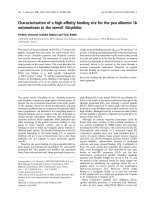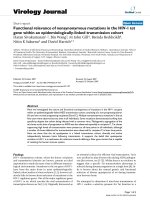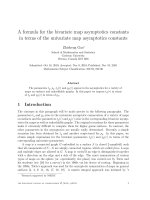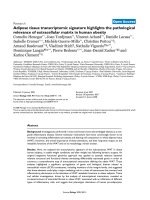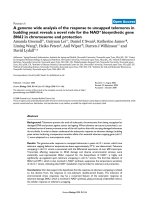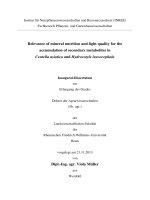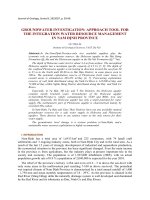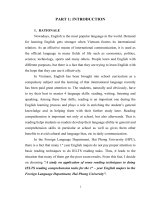Relevance of mineral nutrition and light quality for the accumulation of secondary metabolites in centella asiatica and hydrocotyle leucocephala
Bạn đang xem bản rút gọn của tài liệu. Xem và tải ngay bản đầy đủ của tài liệu tại đây (2.15 MB, 149 trang )
Institut für Nutzpflanzenwissenschaften und Ressourcenschutz (INRES)
Fachbereich Pflanzen- und Gartenbauwissenschaften
Relevance of mineral nutrition and light quality for the
accumulation of secondary metabolites in
Centella asiatica and Hydrocotyle leucocephala
Inaugural-Dissertation
zur
Erlangung des Grades
Doktor der Agrarwissenschaften
(Dr. agr.)
der
Landwirtschaftlichen Fakultät
der
Rheinischen Friedrich-Wilhelms-Universität
Bonn
vorgelegt am 21.11.2013
von
Dipl.-Ing. agr. Viola Müller
aus
Werdohl
Referent:
Prof. Dr. Georg Noga
Korreferent:
Prof. Dr. Matthias Wüst
Tag der mündlichen Prüfung:
19.12.2013
Erscheinungsjahr:
2014
III
Relevance of mineral nutrition and light quality for the accumulation of secondary metabolites
in Centella asiatica and Hydrocotyle leucocephala
The key objective of the present work was to acquire fundamental knowledge on the impact of nutrient
supply and light quality on the accumulation of pharmaceutically relevant secondary metabolites,
particularly saponins and lignans, using Centella asiatica and Hydrocotyle leucocephala as examples.
Experiments on the impact of N, P, and K supply on saponin and sapogenin (centelloside)
accumulation in leaves of C. asiatica were conducted in the greenhouse using soilless culture.
Thereby, the relationship between plant growth and centelloside accumulation as influenced by
nutrient supply was investigated. Furthermore, the suitability of fluorescence-based indices for nondestructive tracking of centelloside accumulation in vivo was examined. For this purpose, different
levels of N, P, and K supply were selected as experimental factors. In order to investigate the effects
of light quality on saponin and lignan accumulation, experiments were conducted in technically
complex sun simulators providing almost natural irradiance. Here, we postulated that high intensity of
photosynthetic active radiation (PAR) and ambient level of ultraviolet (UV)-B radiation additively
promote the accumulation of centellosides in leaves of C. asiatica. The specific UV-B response in
terms of flavonoid accumulation was monitored in vivo by fluorescence recordings. Finally, the impact
of different PAR/UV-B combinations on the concentration and distribution pattern of selected
phenylpropanoids, and in particular the lignan hinokinin, was examined in leaves and stems of H.
leucocephala. The results ascertained in the single chapters can be summarized as follows:
1. The higher levels of N, P, or K supply (in the range from 0 to 150% of the amount in a standard
Hoagland solution) enhanced net photosynthesis (Pn) and herb and leaf yield of C. asiatica.
However, exceeding nutrient-specific thresholds, the high availability of one single nutrient
caused lower leaf N concentrations and a decline in Pn and plant growth. Irrespective of N, P, and
K supply, the leaf centelloside concentrations were negatively associated with herb and leaf yield.
Moreover, negative correlations were found between saponins and leaf N concentrations, and
between sapogenins and leaf K concentrations.
2. The accumulation of both flavonoids and anthocyanins was affected by N, P, and K fertigation in
the same way as the centelloside accumulation, indicating that limitations in plant growth were
generally accompanied by higher secondary metabolite concentrations. The fluorescence-based
flavonol (FLAV) and anthocyanin (ANTH_RG) indices correlated fairly with flavonoid and
particularly with anthocyanin concentrations. Moreover, the centellosides were positively
correlated with the FLAV and ANTH_RG indices, and with the BFRR_UV index, which is
considered as universal ‘stress-indicator’. Thus, the indices FLAV, ANTH_RG, as well as
BFRR_UV enabled the in situ monitoring of flavonoid and centelloside concentrations in leaves of
C. asiatica.
3. UV-B radiation favored herb and leaf production of C. asiatica, and induced higher values of the
fluorescence-based FLAV index. Similarly, the ANTH_RG index and the saponin concentrations
were raised under high PAR. In contrast, UV-B radiation had no distinct effects on saponin and
sapogenin concentrations. In general, younger leaves contained higher amounts of saponins, while
in older leaves the sapogenins were the most abundant constituents.
4. The concentration of the selected phenylpropanoids in H. leucocephala depended on the plant
organ, the leaf age, the light regimes, and the duration of exposure. The distribution pattern of the
compounds within the plant organs was not influenced by the treatments. Based on the chemical
composition of the extracts a principal component analysis enabled a clear separation of the plant
organs and harvesting dates. In general, younger leaves mostly contained higher phenylpropanoid
concentrations than older leaves. Nevertheless, more pronounced effects of the light regimes were
detected in older leaves. As assessed, the individual compounds responded very differently to the
PAR/UV-B combinations. Hinokinin was most abundant in the stems, where its accumulation was
slightly enhanced under UV-B exposure.
IV
Relevanz der Mineralstoffversorgung und der Lichtqualität für die Akkumulation von
Sekundärmetaboliten in Centella asiatica und Hydrocotyle leucocephala
Ziel dieser Arbeit war es, grundlegendes Wissen in Bezug auf den Einfluss des Nährstoffangebots und
der Lichtqualität auf die Akkumulation von pharmazeutisch relevanten Sekundärmetaboliten,
insbesondere Saponinen und Lignanen, zu erlangen, wobei Centella asiatica und Hydrocotyle
leucocephala als Modellpflanzen dienten. Versuche zum Einfluss des N-, P- und K-Angebots auf die
Saponin und Sapogenin (Centellosid)-Akkumulation in C. asiatica Blättern wurden im Gewächshaus
in hydroponischer Kultur durchgeführt. Dabei wurde die Beziehung zwischen Pflanzenwachstum und
Centellosid-Akkumulation in Abhängigkeit vom Nährstoffangebot untersucht. Weiterhin wurde die
Eignung von Fluoreszenz-basierten Indizes für die nicht-destruktive Erfassung der CentellosidAkkumulation in vivo geprüft. Dazu wurde ein unterschiedliches N-, P- und K-Angebot als
experimenteller Faktor gewählt. Um die Effekte der Lichtqualität auf die Saponin- und LignanAkkumulation zu untersuchen, wurden Experimente in technisch komplexen Sonnensimulatoren
durchgeführt, die eine nahezu natürliche Strahlung generierten. Die Studien basierten auf der Hypothese, dass eine hohe photosynthetisch aktive Strahlung (PAR) und eine ambiente Ultraviolett (UV)-B
Intensität die Centellosid-Akkumulation in C. asiatica Blättern additiv fördern. Die spezifische UV-B
Antwort, d.h. die Akkumulation von Flavonoiden, wurde mit Hilfe von Fluoreszenz-Messungen in
vivo verfolgt. Schließlich wurde der Einfluss von verschiedenen PAR/UV-B Kombinationen auf die
Konzentration und das Verteilungsmuster von ausgewählten Phenylpropanoiden, insbesondere dem
Lignan Hinokinin, in den Blättern und Stängeln von H. leucocephala untersucht. Die in den einzelnen
Kapiteln ermittelten Ergebnisse können wie folgt zusammengefasst werden:
1. Ein höheres N-, P- bzw. K-Angebot (im Bereich von 0 bis 150% der Nährstoffmenge in einer
Standard Hoagland-Nährlösung) erhöhte die Nettophotosyntheserate (Pn) und den Kraut- und
Blattertrag von C. asiatica. Bei Überschreitung nährstoffspezifischer Schwellenwerte hatte die
hohe Verfügbarkeit der einzelnen Nährstoffe niedrigere Blatt N-Konzentrationen und eine
Abnahme der Pn und des Pflanzenwachstums zur Folge. Unabhängig vom N-, P- und K-Angebot
war die Centellosid-Konzentration negativ mit dem Kraut- und Blattertrag assoziiert. Des
Weiteren wurden negative Korrelationen zwischen den Saponinen und der Blatt N-Konzentration
und zwischen den Sapogeninen und der Blatt K-Konzentration gefunden.
2. Die Flavonoid- und Anthozyan-Akkumulation wurde durch die N-, P- und K-Fertigation auf die
gleiche Weise beeinflusst wie die Centellosid-Akkumulation, was darauf hinweist, dass ein
limitiertes Pflanzenwachstum generell mit einer höheren Konzentration an Sekundärmetaboliten
einherging. Die Fluoreszenz-basierten Flavonol- (FLAV) und Anthozyan- (ANTH_RG) Indizes
korrelierten gut mit den Flavonoid- und insbesondere mit den Anthozyan-Konzentrationen. Zudem
korrelierten die Centelloside positiv mit den FLAV und ANTH_RG Indizes sowie dem
BFRR_UV Index, der als universeller ‚Stressindikator‘ betrachtet wird. Somit ermöglichten die
Indizes FLAV, ANTH_RG und BFRR_UV die in situ Beobachtung der Flavonoid- und
Centellosid-Konzentration in den Blättern von C. asiatica.
3. UV-B Strahlung förderte die Kraut- und Blattproduktion von C. asiatica, und induzierte höhere
Werte des Fluoreszenz-basierten FLAV Index. Ebenso waren der ANTH_RG Index und die
Saponin-Konzentration unter hoher PAR Intensität erhöht. Im Gegensatz dazu hatte UV-B
Strahlung keine eindeutigen Effekte auf die Saponin- und Sapogenin-Konzentrationen.
Grundsätzlich enthielten jüngere Blätter höhere Saponin-Konzentrationen, während in älteren
Blättern die Sapogenine die am häufigsten vorkommenden Substanzen waren.
4. Die Konzentration der ausgewählten Phenylpropanoide in H. leucocephala war abhängig von
Pflanzenorgan, Blattalter, Lichtzusammensetzung und Behandlungsdauer. Das Verteilungsmuster
der Substanzen zwischen den Pflanzenorganen wurde nicht durch die Behandlungen beeinflusst.
Basierend auf der chemischen Komposition der Extrakte ermöglichte eine Hauptkomponentenanalyse eine klare Trennung der Pflanzenorgane und Erntetermine. Grundsätzlich enthielten
jüngere Blätter meist höhere Phenylpropanoid-Konzentrationen als ältere Blätter. Stärkere Effekte
der Lichtzusammensetzung wurden jedoch in älteren Blättern detektiert. Wie festgestellt,
reagierten die einzelnen Substanzen sehr unterschiedlich auf die PAR/UV-B Kombinationen.
Hinokinin kam am häufigsten im Stängel vor, wo die Akkumulation unter UV-B Strahlung leicht
erhöht war.
V
Table of Contents
A
Introduction ....................................................................................................................... 1
1
Plant secondary metabolites and their importance for medicinal purposes .................... 1
2
The need for a well-directed cultivation of medicinal plants .......................................... 1
3
Selected plant species, active constituents, and medicinal usage .................................... 2
4
5
6
3.1
Centella asiatica ...................................................................................................... 2
3.2
Hydrocotyle leucocephala ....................................................................................... 4
Biosynthesis of the active constituents ............................................................................ 5
4.1
Saponins ................................................................................................................... 5
4.2
Lignans ..................................................................................................................... 6
Effects of abiotic factors on the accumulation of plant secondary metabolites .............. 6
5.1
Nutrient supply......................................................................................................... 7
5.2
Light quality ............................................................................................................. 9
Potential use of non-destructive fluorescence recordings for research and cultivation
of medicinal plants ........................................................................................................ 11
7
Objectives of the study .................................................................................................. 13
8
References ..................................................................................................................... 15
B
Centelloside accumulation in leaves of Centella asiatica is determined by
resource partitioning between primary and secondary metabolism while
influenced by supply levels of either nitrogen, phosphorus, or potassium ................ 26
1
Introduction ................................................................................................................... 26
2
Materials and methods ................................................................................................... 28
2.1
Plant material ......................................................................................................... 28
2.2
Experimental and growth conditions ..................................................................... 28
2.3
Sampling and sample preparation .......................................................................... 29
2.4
Determination of N, P, and K concentrations in leaves ......................................... 30
2.5
Determination of saponin, sapogenin, and total centelloside concentrations
in leaves ................................................................................................................. 30
3
2.6
Net photosynthesis ................................................................................................. 32
2.7
Statistics ................................................................................................................. 32
Results ........................................................................................................................... 32
3.1
Effect of nitrogen supply ....................................................................................... 32
3.2
Effect of phosphorus supply .................................................................................. 36
VI
3.3
Effect of potassium supply..................................................................................... 39
4
Discussion...................................................................................................................... 42
5
References ..................................................................................................................... 49
C
Estimation of flavonoid and centelloside accumulation in leaves of
Centella asiatica L. Urban by multiparametric fluorescence measurements ............ 54
1
Introduction ................................................................................................................... 54
2
Materials and methods ................................................................................................... 56
3
4
2.1
Experimental setup................................................................................................. 56
2.2
Non-destructive, fluorescence-based determinations ............................................ 56
2.3
Determination of flavonoid and anthocyanin concentrations ................................ 57
2.4
Extraction and determination of saponin and sapogenin concentrations ............... 57
2.5
Statistics ................................................................................................................. 58
Results ........................................................................................................................... 58
3.1
Flavonoid and anthocyanin accumulation ............................................................. 58
3.2
Fluorescence-based flavonol (FLAV) and anthocyanin (ANTH_RG) indices...... 60
3.3
Correlation analysis ............................................................................................... 62
Discussion...................................................................................................................... 65
4.1
Flavonoid and anthocyanin accumulation in response to N, P, or K supply ......... 65
4.2
Temporal development of the FLAV and ANTH_RG indices .............................. 66
4.3
FLAV and ANTH_RG indices: robust indicators for the monitoring of
centelloside concentrations? .................................................................................. 67
5
D
References ..................................................................................................................... 72
Ecologically relevant UV-B dose combined with high PAR intensity distinctly
affect plant growth and accumulation of secondary metabolites in leaves of
Centella asiatica L. Urban............................................................................................... 76
1
Introduction ................................................................................................................... 76
2
Materials and methods ................................................................................................... 78
2.1
Plant material ......................................................................................................... 78
2.2
Treatments and growth conditions ......................................................................... 78
2.3
Multiparametric fluorescence measurements ........................................................ 79
2.4
Gas-exchange measurements ................................................................................. 80
2.5
Sampling and sample preparation .......................................................................... 80
VII
2.6
Determination of saponin, sapogenin, and total centelloside concentrations
in leaves ................................................................................................................. 81
2.7
3
4
Statistics ................................................................................................................. 81
Results ........................................................................................................................... 81
3.1
Vegetative growth and net photosynthesis ............................................................ 81
3.2
Fluorescence-based indices .................................................................................... 82
3.3
Concentration of centellosides ............................................................................... 84
Discussion...................................................................................................................... 87
4.1
PAR and UV-B have distinct impact on plant growth and accumulation of
secondary metabolites ........................................................................................... 87
4.2
5
E
Relevance of the age of the tissue .......................................................................... 90
References ..................................................................................................................... 95
Distribution pattern and concentration of phenolic acids, flavonols, and
hinokinin in Hydrocotyle leucocephala is differently influenced by PAR and
ecologically relevant UV-B level .................................................................................. 101
1
Introduction ................................................................................................................. 101
2
Materials and methods ................................................................................................. 103
3
2.1
Plant material ....................................................................................................... 103
2.2
Irradiation regimes and growth conditions .......................................................... 103
2.3
Sampling and sample preparation ........................................................................ 104
2.4
Identification and quantification of phenylpropanoid compounds ...................... 104
2.5
Statistics ............................................................................................................... 105
Results ......................................................................................................................... 105
3.1
Chromatography and peak identity ...................................................................... 105
3.2
Impact of the experimental factors on the accumulation of phenylpropanoids:
an overview ......................................................................................................... 107
3.3
Distribution pattern of phenylpropanoids in leaves and stems ............................ 107
3.4
Effect of the PAR/UV-B combinations on the concentration of
phenylpropanoids in leaves and stems ................................................................ 110
4
Discussion.................................................................................................................... 116
4.1
Phenylpropanoid compounds in the H. leucocephala plants ............................... 116
4.2
Distribution pattern and concentration of the phenylpropanoids as influenced
by the light regimes ............................................................................................. 117
5
References ................................................................................................................... 127
VIII
F
Summary and conclusion ............................................................................................. 134
IX
List of abbreviations
ANOVA
ANTH_RG
BFRR_UV
C
C. asiatica
Ca(NO3)2
cm
CNB
CO2
CoA
CuSO4
cv.
°C
DM
DMAPP
DNA
e.g.
EC
ESI-MS
et al.
etc.
fam.
FeSO4
Fig. (sg.), Figs. (pl.)
FLAV
FPP
FRF
g
GDB
Glu
GPP
H
h
H. leucocephala
H2MoO4
H2O
H3BO3
H3COOHCA
HCl
HNO3
HPLC
HY
i.e.
IPP
analysis of variance
decadic logarithm of the red to green excitation ratio of far-red
chlorophyll fluorescence
ultraviolet excitation ratio of blue-green and far-red chlorophyll
fluorescence
carbon
Centella asiatica L. Urban
calcium nitrate
centimeter
carbon-nutrient balance
carbon dioxide
coenzyme A
copper(II) sulfate
cultivar
degree Celsius
dry mass
dimethylallyl diphosphate
deoxyribonucleic acid
exempli gratia, for example
electrical conductivity
electrospray ionization - mass spectrometry
et alii (m.), et aliae (f.), and others
et cetera
family
iron(II) sulfate
figure (sg.), figures (pl.)
decadic logarithm of the red to ultraviolet excitation ratio of far-red
chlorophyll fluorescence
farnesyl diphosphate
far-red fluorescence
gram
growth-differentiation balance
glucose
geranyl diphosphate
hydrogen
hours
Hydrocotyle leucocephala Cham. & Schlecht.
molybdic acid
water
boric acid
acetate anion
hydroxycinnamic acid
hydrogen chloride
nitric acid
high-performance liquid chromatography
herb yield
id est, that is
isopentyl diphosphate
X
IR
K
K2O
KCl
KH2PO4
kV
L
LT
LY
m
M
[M]
m/z
MeOH
MEP
mg
MgO
MgSO4
min
mL
mm
MnSO4
MoO3
mS
MVA
mW
µg
µm
µmol
N
n
n.s.
NaCl
(NH4)2SO4
(NH4)H2PO4
nm
nmol
OH
OPPP
%
% m m-1
P
p
P2O5
p.a.
PAM
PAR
PC
PCA
PCM
PFA
infrared radiation
potassium
potassium oxide
potassium chloride
potassium dihydrogen phosphate
kilovolt
liter
leaf type
leaf yield
meter
molar (mole per liter)
molar mass
mass-to-charge ratio
methanol
methylerythritol phosphate
milligram
magnesium oxide
magnesium sulphate
minutes
milliliter
millimeter
manganese(II) sulfate
molybdenum(VI) oxide
millisiemens
mevalonate
milliwatt
microgram
micrometer
micromole
nitrogen
number of replications
not significant
natrium chloride
ammonium sulphate
ammonium dihydrogen phosphate
nanometer
nanomole
hydroxide
oxidative pentose phosphate pathway
percent
percent mass per mass
phosphorous
probability of error
phosphorus pentoxide
pro analysi
pulse-amplitude-modulated
photosynthetic active radiation
principal component
principal component analysis
protein competition model
perfluoroalkoxy
XI
Pn
ppm
r
rel.
Rha
ROS
rpm
s
S
spp.
syn.
UHPLC
UV
V
v/v
VIS
W
WTA
ZnSO4
net photosynthesis
parts per million
Pearson’s correlation coefficient
relative
rhamnose
reactive oxygen species
revolutions per minute
second
sulfur
species
synonym
ultra-high-performance liquid chromatography
ultraviolet
volt
volume per volume
visible
watt
weeks of treatment application
zinc sulfate
1
A
Introduction
1
Plant secondary metabolites and their importance for medicinal purposes
Plant secondary metabolites are chemicals produced by plants in a vast diversity of more
than 200,000 structures (Hartmann, 2007). Contrary to primary metabolites, secondary
metabolites are not essential for growth processes but enable the plant to adapt to the
environment, e.g., by serving as feeding deterrents against herbivores, protective agents
against pathogens or abiotic factors, pollinator attractants, antioxidants, or chemical signals
(Croteau et al., 2000; Wink, 2003).
Owing to the bioactivity of these chemicals, plants have been utilized as medicines for
thousands of years. Initially, these medicines were administered as crude drugs, such as teas,
tinctures, poultices, powders, and other herbal formulations (Balick and Cox, 1997;
Samuelsson, 2004). In more recent history, progress in analytical chemistry enabled the
isolation and the pharmaceutical usage of single compounds, starting with the isolation of
morphine from opium poppy in the early 19th century (Hamburger and Hostettmann, 1991;
Hamilton and Baskett, 2000; Li and Vederas, 2009). Despite the success of drugs derived
from natural sources, the tremendous development of synthetic pharmaceutical chemistry and
microbial fermentation in the 20th century led to a declining interest of the pharmaceutical
companies in natural product research (Hamburger and Hostettmann, 1991). However, in
recent years herbal drugs have gained renewed attention, mainly because of ecological
awareness and an increased demand in alternative therapies (Hamburger and Hostettmann,
1991; Calixto, 2000; Roggo, 2007). It has been estimated that to date only a small percentage
of the ca. 250,000 species of higher plants has been investigated for pharmacological active
constituents. Thus, there is still an enormous potential for the discovery and development of
new drugs from plant resources (McChesney et al., 2007; Li and Vederas, 2009).
2
The need for a well-directed cultivation of medicinal plants
To meet the increasing market demand for herbal medicines, a large proportion of the raw
material is collected from wild plant populations (Schippmann et al., 2006; Cordell, 2009). As
a consequence, uncontrolled harvesting, limited cultivation, and insufficient attempts of
replacement of the plants result in depletion of wild stock, extinction of endangered species,
and shrinking of biodiversity (Rates, 2001; Schippmann et al., 2006; Cordell, 2009). Beyond,
the collected material often does not match high quality standards because of contaminants
like heavy metals, toxic or hazardous substances, microbes, or undesirable plant species.
2
Further problems are the insecurity of long-range availability of plant material as well as
variable or unsatisfactory contents of the target biochemicals (Calixto, 2000; McCaleb et al.,
2000; Gurib-Fakim, 2006; McChesney et al., 2007; Cordell, 2009; Prasad et al., 2012).
Therefore, a well-directed cultivation of the medicinal plants would contribute to the
continuous availability and to an improved quality of safe raw material (Calixto, 2000; Rates,
2001). However, in dependence on the compound class, the content of bioactive constituents
may be affected, e.g., by light, temperature, and nutrient supply, as well as time of harvest and
the physiological stage of the plant (Li et al., 2008; Selmar and Kleinwächter, 2013). Thus, to
achieve high yields of the desired secondary compounds, a precise knowledge on optimum
conditions for its biosynthesis and for plant development is necessary.
3
Selected plant species, active constituents, and medicinal usage
3.1 Centella asiatica
Centella asiatica L. Urban (syn.: Hydrocotyle asiatica L., fam.: Apiaceae) is a perennial
creeping herb (Fig. 1), which flourishes in marshy areas of tropical to subtropical regions
(Cepae, 1999; James and Dubery, 2009).
Fig. 1. Centella asiatica L. Urban. Insert: Inconspicuous pale purple flowers arranged in shortly
petiolate umbels.
The aerial parts of C. asiatica, or even the entire plant, have been used for therapeutic
applications since ancient times. In some cultures, the herb is also consumed as a vegetable
(Sritongkul et al., 2009). In folk medicine C. asiatica is used for many purposes, including the
treatment of skin disorders, respiratory problems, nervous disorders, infectious diseases, and
gastro-intestinal diseases. Furthermore, different pharmacopoeias and traditional systems of
medicine report on the usage of the plant, e.g., in the therapy of leprous ulcers, venous
3
disorders, and hepatic cirrhosis. Beyond, its efficacy in the treatment of wounds, burns,
ulcerous skin ailments, and stomach or duodenal ulcers, as well as in the prevention of keloid
and hypertrophic scars, has already been confirmed in clinical studies (Hausen, 1993; WHO,
1999 and references therein).
The pharmacological activity of C. asiatica is attributed mainly to pentacyclic triterpene
saponins, the centellosides, which are preferentially accumulated in the leaves of the plant.
The most important saponins are asiaticoside and madecassoside, and their respective genins
asiatic acid and madecassic acid (Fig. 2) (Inamdar et al., 1996). In addition, C. asiatica
contains mono- and sesquiterpenoids (Oyedeji and Afolayan, 2005), polysaccharides (Wang
et al., 2004), polyacetylenes (Siddiqui et al., 2007; Govindan et al., 2007), sterols (Srivastava
and Shukla, 1996; Rumalla et al., 2010; Sondhi et al., 2010), phenolic acids, and flavonoid
derivatives (Kuroda et al., 2001; Matsuda et al., 2001; Yoshida et al., 2005; Subban et al.,
2008). The latter are generally considered to promote human health and to prevent
cardiovascular diseases and cancer (Ross and Kasum, 2002; Fraga et al., 2010). Besides, the
nutritional value of the plant is related to its notable contents of fiber, protein, calcium, and
beta-carotin (Sritongkul et al., 2009).
O
HO
R2
O
HO
R1
OH
asiaticoside
madecassoside
asiatic acid
madecassic acid
R1 = H
R1 = OH
R1 = H
R1 = OH
R2 = Glu-Glu-Rha
R2 = Glu-Glu-Rha
R2 = H
R2 = H
Fig. 2. Chemical structure of asiaticoside, madecassoside, asiatic acid, and madecassic acid. Glu,
glucose; Rha, rhamnose.
During the last years, C. asiatica based drugs and cosmetics have gained significant
economic interest worldwide (James and Dubery, 2009; Devkota et al., 2010a; Singh et al.,
2010). Despite of this, the commercial cultivation of the plant is largely underexplored and
the market’s demand is predominantly satisfied by wild harvesting from nature. Thus,
4
unrestricted exploitation of the drug has markedly depleted spontaneous populations of C.
asiatica and may lead to the extinction of valuable genotypes (Singh et al., 2010; Thomas et
al., 2010). On the other hand, centelloside concentrations in the raw material are known to
vary in dependence on the collected genotypes, geographic regions, and growth conditions
(Randriamampionona et al., 2007; Devkota et al., 2010a, b; Thomas et al., 2010).
Consequently, the raw material is often of poor quality owing to low contents of bioactive
compounds. Therefore, research-based developments of cultivation techniques are needed in
order to encourage the commercial production of C. asiatica raw material containing high
amounts of the bioactive compounds.
3.2 Hydrocotyle leucocephala
Hydrocotyle leucocephala Cham. & Schlecht. (fam.: Araliaceae) is a perennial
stoloniferous creeper (Fig. 3), indigenous to South America. The aquatic plant is able to grow
even submerse and occurs abundantly in wet and marshy habitats (Alvarez, 2001; Ramos et
al., 2006).
Fig. 3. Hydrocotyle leucocephala Cham. & Schlecht.. Insert: Small white flowers arranged in simple
long petiolate umbels.
The leaves of H. leucocephala are edible and, owing to their peppery taste, they are used
as a spice or for the preparation of a soda in some tropical countries. In Colombia the plant is
used as medicinal herb because of its diuretic, antihelminthic, and antidiarrheal properties
(Ramos et al., 2006).
Up to now, a number of secondary compounds have been isolated from the aerial parts of
H. leucocephala, including three diacetylenic compounds, two monoterpenoids, seven
leucoceramides, six leucocerebrosides, one sterol, one nor-isoprenoid, one megastigmane
derivative, four flavonoids, and the dibenzylbutyrolactone lignan (–)-hinokinin (Fig. 4). Some
of them, e.g., hinokinin were shown to possess immunosuppressive activity (Ramos et al.,
5
2006). Beyond, hinokinin is considered to be a potent agent, e.g., against human hepatitis-B
virus (Huang et al., 2003) and Trypanosoma cruzi, the pathogen of Chagas disease (e Silva et
al., 2004; Saraiva et al., 2007). Moreover, hinokinin was shown to have anti-inflammatory
and analgesic properties (da Silva et al., 2005). Thus, H. leucocephala is a promising source
for several secondary metabolites, which potentially might be considered for the development
of new drugs. So far, neither there is information on the propagation and cultivation of the
species, nor on the significance of growth conditions for the accumulation of biochemicals in
the tissue.
O
O
O
O
O
O
Fig. 4. Chemical structure of (–)-hinokinin.
4
Biosynthesis of the active constituents
4.1 Saponins
Pentacyclic triterpene saponins, including the centellosides, are synthesized via the
isoprenoid pathway starting with isopentyl diphosphate (IPP) and dimethylallyl diphosphate
(DMAPP). Two biosynthetic routes for the generation of IPP and DMAPP have been
characterized, i.e., the cytosolic mevalonate (MVA) pathway, which uses acetyl-CoA as
biosynthetic precursor, and the plastidal methylerythritol phosphate (MEP) pathway, by
which IPP and DMAPP are formed from pyruvate and glyceraldehyde phosphate. While in
the MEP pathway both IPP and DMAPP are produced simultaneously, the MVA pathway
only yields IPP, which is finally converted into DMAPP. In higher plants both pathways are
operative, and even a metabolic cross-talk between them may exist (Hemmerlin et al., 2012;
Vranová et al., 2013). However, evidences show that under standard growth conditions
triterpenes, such as saponins, are synthesized mainly in the cytosol utilizing IPP from the
MVA pathway (Rohmer, 1999; Trojanowska, 2000; Chappell, 2002; Kirby and Keasling,
2009; Hemmerlin et al., 2012).
6
The condensation of one IPP molecule and one DMAPP molecule, respectively, leads to
geranyl diphosphate (GPP), and the subsequent addition of another IPP unit originates
farnesyl diphosphate (FPP). Then, the linkage of two FPP units generates squalene, which is
epoxygenated to 2,3-oxidosqualene. The cyclization of 2,3-oxidosqualene leads to the
tetracyclic dammarenyl cation, which is transformed via several intermediates into the
pentacyclic α- and β-amyrins. The latter undergo various modifications, i.e., oxidation,
hydroxylation, and other substitutions to form the C. asiatica sapogenins. Finally, the
sapogenins are converted into saponins by glycosylation processes (James and Dubery, 2009;
Augustin et al., 2011).
4.2 Lignans
Dibenzylbutyrolactone
lignans,
such
as
hinokinin,
belong
to
the
group
of
phenylpropanoids. The biosynthetic precursor, coniferyl alcohol, is formed in the general
phenylpropanoid and the cinnamate/monolignol pathway. At first, the deamination of the
aromatic amino acid phenylalanine leads to cinnamic acid, which is hydroxylated via pcoumaric acid into caffeic acid. Caffeic acid is transformed into ferulic acid, which is
converted via feruloyl-CoA and coniferyl aldehyde into coniferyl alcohol (Sakakibara et al.,
2007; Suzuki and Umezawa, 2007).
The formation of (–)-hinokinin starts with the enantioselective dimerization of two
coniferyl alcohol units mediated by a dirigent protein, resulting in (+)-pinoresinol.
Subsequently, (+)-pinoresinol is reduced via (+)-lariciresinol to (–)-secoisolariciresinol. The
dehydrogenation of (–)-secoisolariciresinol leads to (–)-matairesinol, and finally (–)-hinokinin
originates from the generation of two methylenedioxy bridges, either via (–)-pluviatolide or
via (–)-haplomyrfolin, depending on the benzene ring on which the first methylenedioxy
bridge is formed (Suzuki and Umezawa, 2007; Bayindir et al., 2008).
5
Effects of abiotic factors on the accumulation of plant secondary metabolites
Plants are sessile organisms and inevitably exposed to a diversity of environmental
factors. In order to cope with rapid changes of their surroundings, plants have evolved a wide
spectrum of acclimation responses, including the accumulation of secondary metabolites
(Wink, 2003; Hartmann, 2007).
Saponins are generally considered to be accumulated to protect the plant from pathogens
and herbivores (Augustin et al., 2011). Besides, evidences indicate that the synthesis of
saponins, including centellosides, might be affected by abiotic factors, such as soil fertility
7
and light conditions (Mathur et al., 2000; Devkota et al., 2010a, b; Siddiqui et al., 2011;
Szakiel et al., 2011; Maulidiani et al., 2012; Prasad et al., 2012). In contrast to the saponins,
the function and the inducibility of lignans in herbaceous plants is rather unknown. Some
authors assume that lignans play a role in plant defense against herbivory and pathogen attack
(Gang et al., 1999; Harmatha and Nawrot, 2002). However, precise information is scarce;
beyond, knowledge on the impact of abiotic factors on lignan accumulation is completely
lacking. Since lignans belong to the group of phenylpropanoids and UV-B radiation is known
to induce the expression of key-enzymes of the phenylpropanoid pathway, e.g., phenylalanine
ammoniumlyase (Chappell and Hahlbrock, 1984; Strid et al., 1994; Jenkins et al., 2001), it is
conceivable that the synthesis of lignans might be affected by the spectral composition of
light.
5.1 Nutrient supply
Nitrogen (N), along with phosphorus (P) and potassium (K), is one mineral required by
the plants in large amounts. N is an essential constituent of proteins, nucleic acids, nucleotids,
chlorophyll, co-enzymes, and phytohormones. P is incorporated into various organic
compounds, including nucleic acids, sugar phosphates, adenosine phosphates, and
phospholipids. In addition, it controls several key enzyme reactions and is necessary for the
transfer of carbohydrates in leaf cells. K plays a major role in osmoregulation and is important
for cell extension and stomata movement. It stimulates phloem loading of sucrose, affects the
rate of mass flow-driven solute movement within the plant, and activates a number of
enzymes (Epstein and Bloom, 2005; Marschner, 2012 and references therein).
Variations in N, P, and K availability may influence resource allocation between primary
and secondary metabolism, and consequently affect the concentration of secondary
metabolites in the plant tissues (Coley et al., 1985; Lattanzio et al., 2009). Efforts to explain
the patterns of resource allocation led to the emergence of several hypotheses, such as the
carbon-nutrient balance hypothesis (CNB) (Bryant et al., 1983), the growth-differentiation
balance hypothesis (GDB) (Herms and Mattson, 1992), and the protein competition model
(PCM) (Jones and Hartley, 1999). Both the CNB and the GDB assume that in conditions of
low nutrient availability growth is more restricted than photosynthesis. Consequently, fixed
carbon is accumulated in excess of growth requirements and is invested in the synthesis of
carbon-based secondary metabolites, such as terpenoids or phenols (Watson, 1963; Epstein,
1972; Smith, 1973; McKey, 1979; Bryant et al., 1983). In contrast, the PCM suggests that the
synthesis of phenolic compounds is rather inversely related to the formation of proteins, since
8
both compete for the same limited precursor phenylalanine (Jones and Hartley, 1999).
Nevertheless, all the three hypotheses assume a trade-off between growth and the biosynthesis
of secondary metabolites (Coley et al., 1985).
In the literature, a number of studies report on the enhanced biosynthesis of phenols, e.g.,
flavonoids, in response to nutrient limitations, paralleled by constraints in plant growth
(Muzika, 1993; Haukioja, 1998; Hale et al., 2005). On the contrary, results on terpenoid
formation as influenced by nutrient supply are less consistent (Mihaliak and Lincoln, 1985;
Muzika, 1993; Haukioja, 1998). Analogous to that, there are contradictory findings on the
effects of nutrient availability on the accumulation of saponins in plants. In this context, the
application of cattle manure enhanced plant growth and berry yield of Phytolacca dodecandra
L’Hérit, but it generally decreased the content of triterpene saponins in the berries (Ndamba et
al., 1996). On the contrary, the content of steroidal furostanol and spirostanol saponins in
roots of Asparagus racemosus Willd. increased in response to N, P, and K fertilization (Vijay
et al., 2009). Accordingly, N and P fertilization led to an enhancement in plant growth and
steroidal saponin content in shoots of Tribulus terrestris L. (Georgiev et al., 2010). Moreover,
the application of moderate doses of N and P, particularly when applied in combinations,
promoted saikosaponin contents in roots of Bupleurum chinense; on the other hand, the
additional increase in nutrient supply in turn decreased saponin production (Zhu et al., 2009).
The inconsistent findings summarized above might be explained by the divergent
experimental designs, genotypes, and growing conditions, as well as by the target organ
which was investigated. At all, this diversity makes comparisons with C. asiatica, which
accumulates saponins preferentially in the leaves, very difficult. Moreover, even fertilization
studies of C. asiatica revealed divergent findings. On the one hand, some studies report on a
negative impact of fertilization and nutrient rich soil on saponin and sapogenin concentrations
in C. asiatica plants (Devkota et al., 2010a, b). Similar results were observed for multiple
shoot cultures having higher asiaticoside concentrations at lower N levels in the culture media
(Prasad et al., 2012). On the other hand, there are also studies reporting on a positive impact
of N fertilization on plant growth as well as the accumulation of saponins and sapogenins in
C. asiatica plants (Siddiqui et al., 2011). Hence, precise information on the relationship
among plant growth, physiology, and centelloside biosynthesis in response to mineral
nutrition is urgently needed.
9
5.2 Light quality
Plants are photoautotrophic organisms and depend on the absorption and utilization of
sunlight as a source of energy driving photosynthesis. Moreover, light is an informational
signal directing growth, differentiation, and metabolism of the plants (Kendrick and
Kronenberg, 1994; Fankhauser and Chor, 1997).
Sunlight reaching the Earth’s surface encompasses ultraviolet-B (UV-B, 280–315 nm),
ultraviolet-A (UV-A, 315–400 nm), photosynthetic active (PAR, 400–700 nm), and infrared
radiation (IR, >700 nm) (Fig. 5). Since wavelengths below 290 nm are efficiently absorbed by
the stratospheric ozone layer, only a small proportion of UV-B radiation is transmitted to the
Earth’s surface (Pyle, 1997; McKenzie et al., 2003). Nevertheless, UV-B radiation is the most
energetic component of the daylight spectrum and has the potential to affect growth,
development, reproduction, and survival of many organisms, including plants (Caldwell et al.,
2007). The effects of UV-B radiation on plants depend on various factors, e.g., the fluence
rate, duration of exposure, the wavelengths, and the interaction with other environmental
signals, such as other spectral wavelengths (Caldwell et al., 2003).
As a consequence of ozone depletion, UV-B radiation reaching the Earth’s surface has
increased during the last decades. Therefore, numerous studies published during the 19702000s dealt with the impact of enhanced UV-B levels on plants. These studies revealed that
high fluence rates of UV-B generate high levels of reactive oxygen species and may damage
macromolecules, such as DNA, proteins, and membrane lipids, which consequently leads to
alterations in photosynthesis and reductions in growth (Teramura and Sullivan, 1994; Jansen
et al., 1998 and references therein). However, during recent years, ozone depletion has been
reduced significantly, and the dramatic forecasts were not confirmed. These facts, along with
major advances in experimental manipulation of UV-B radiation, led to a shift of the
scientific focus towards the influence of lower but ecologically relevant UV-B levels on
plants (Jansen and Bornman, 2012). Correspondingly, it was elucidated that harmful effects
are predominantly induced by above-ambient UV-B doses, which trigger the expression of
stress-related genes mediated by unspecific pathways, similar to those of wound-signaling and
pathogen-defense. Differently, environmentally relevant fluence rates of UV-B radiation
activate specific, photomorphogenic signaling pathways, which induce a range of genes
involved in UV protection and/or the amelioration of UV damage (Jenkins and Brown, 2007;
Jenkins, 2009).
10
Fig. 5. Typical spectrum of global irradiance and ranges of UV-B, UV-A, and PAR measured at the
Helmholtz Zentrum München, Germany (11.6 East, 48.2 North, 489 m above sea level) on a
sunny spring day (Albert et al., 2006).
A well-known protective mechanism in plants against the UV-B wavelengths is the
increased accumulation of phenolic compounds, including flavonoids (Li et al., 1993;
Frohnmeyer and Staiger, 2003). Beyond, flavonoid synthesis was also shown to be induced by
high PAR intensity even in the absence of the UV-B range (Nitz et al., 2004; Götz et al.,
2010; Agati et al., 2011). Nevertheless, the presence of UV-B radiation additively promoted
flavonoid accumulation (Nitz et al., 2004; Götz et al., 2010; Agati et al., 2011), which
substantiates the necessity of the additional consideration of other wavelengths when
evaluating the UV-B impact on plants.
Analogous to the flavonoids, even the accumulation of saponins was proposed to be
influenced either by UV-B radiation or by PAR intensity. Accordingly, the glycyrrhizin
concentrations in Glycyrrhiza uralensis roots were enhanced after UV-B exposure (Afreen et
al., 2005). Moreover, cultivation of Phytolacca dodecandra L’Hérit in shade led to a lower
berry yield and to lower triterpene saponin concentrations than cultivation in full sunlight
(Ndamba et al., 1996). Similarly, the roots of Panax quinquefolius plants grown in the
understory of a broadleaf forest contained higher ginsenoside concentrations when the plants
were exposed to longer sun flecks as compared to those exposed to shorter periods of direct
sunlight; although the overexposure to light intensity led to a decrease in the concentrations
(Fournier et al., 2003). In contrast, fruits of Diospyros abyssinica (Hiern) F. White in the
11
upper crown of the tree, and therefore exposed to higher light intensity, were found to contain
less triterpenoid saponins (derivatives of betulin and betulinic acid) than lower crown fruits,
which were exposed to lower light intensity (Houle et al., 2007).
Finally, similar to the reports on nutrient supply, investigations on light revealed
divergent findings concerning the impact of its intensity and quality on saponin
concentrations in plants. Accordingly, some studies on C. asiatica indicate a promoting effect
of higher light intensities on centelloside accumulation (Sritongkul et al., 2009; Devkota et
al., 2010b; Maulidiani et al., 2012), while others report on the opposite, i.e., higher yields of
herbage paralleled by higher concentrations of asiaticoside under 50% shading as compared to
full sunlight (Mathur et al., 2000). Beyond, the controlled combination of UV-B and PAR,
and their influence on the accumulation of saponins has not been investigated, yet.
With regard to the lignans, experiments on the effects of light supply on biosynthesis are
lacking. However, since lignans belong to the group of phenylpropanoids, it has to be
elucidated whether the accumulation of lignans is influenced by different light regimes in the
same extent as the accumulation of other phenylpropanoids, such as flavonoids.
6
Potential use of non-destructive fluorescence recordings for research and cultivation
of medicinal plants
Chlorophyll fluorescence is an optical signal that provides information on the
physiological status of the plant. The general principles of fluorescence are reviewed
elsewhere (e.g., Krause and Weis, 1991; Maxwell and Johnson, 2000; Murchie and Lawson,
2013).
The pulse-amplitude-modulated (PAM) fluorometry is one of the most common
techniques used to measure the light-induced chlorophyll fluorescence reflecting the
photosynthetic performance of the plant tissue (Krause and Weis, 1991; Baker and
Rosenqvist, 2004). However, since the PAM method requires dark-adaptation of the leaf prior
to measurement for optimum results, it often imposes practical limitations. During the last
decade, advances in fluorescence measurement techniques have led to the development of
new portable optical sensors, enabling stable measurements under daylight conditions without
the necessity of dark-adaptation of the leaf (Buschmann et al., 2000). One of these sensors is
the Multiplex® device (Force-A, Orsay, France). The Multiplex®, a multiparametric
fluorescence sensor, measures the fluorescence intensity in the three spectral bands, i.e., red,
far-red, and blue or green, after excitation with different light sources (ultraviolet, blue or
green, and red). The fluorescence signals recorded in these bands are specific to the species
12
which is being evaluated. While the red and far-red fluorescence emanates from chlorophyll
molecules, the blue and green fluorescence are related to phenolic compounds, particularly
the cell wall bound cinnamic acids (Morales et al., 1996; Lichtenthaler and Schweiger, 1998).
However, the absolute fluorescence signals are strongly affected by the distance between
sensor and leaf, the allocation site of the molecules in the tissue, and the leaf structure. Thus,
the calculated fluorescence ratios establish more robust and reliable indices, and are therefore
more suitable, e.g., for the estimation of the chlorophyll, flavonol, and anthocyanin content in
plant tissues (Cerovic et al., 1999; Lichtenthaler et al., 2012). With this rationale, the
chlorophyll content is reflected by the simple fluorescence ratio of far-red and red
fluorescence excited either with green or red light (Lichtenthaler et al, 1986; Buschmann,
2007). Further, the content of epidermal flavonols can be evaluated by the decadic logarithm
of the red to UV excitation ratio of the far-red chlorophyll fluorescence (Cerovic et al., 2002),
while the content of anthocyanins is related to the decadic logarithm of the red to green
excitation ratio of far-red chlorophyll fluorescence (Agati et al., 2005).
Red
excitation
Chlorophyll
fluorescence
UV
excitation
Chlorophyll
fluorescence
Fig. 6. Cross section of a leaf. The comparison of the red and UV excitation quantifies the screening
effect due to polyphenols and therefore the content of the latter in the epidermis (modified after
Force-A, 2010).
The estimation of the content of epidermal flavonols and anthocyanins is based on the
screening properties of the compounds on chlorophyll, which is localized below the epidermis
(Burchard et al., 2000; Bilger et al., 2001). With this method the intensity of chlorophyll
fluorescence excited with red light (not absorbed by flavonols and anthocyanins) is compared
with the intensity of chlorophyll fluorescence excited either with UV (absorbed by flavonols)
or green light (absorbed anthocyanins) (Fig. 6). In this way, the excitation light reaching the
chloroplasts is attenuated by the constituents located in the epidermis. Consequently, the
higher the concentration of absorbing compounds per leaf area, the lower is the intensity of
the chlorophyll fluorescence.
13
As highlighted above, plant tissues accumulate secondary metabolites, including
flavonols and anthocyanins, in order to adapt to their surroundings. Changing environmental
conditions induce alterations in secondary metabolite concentrations, which consequently lead
to changes in the fluorescence intensities. In this context, the potential of specific
fluorescence-based indices has been tested in several studies, e.g., for the early detection of N
deficiency, drought stress, and pathogen infection in agricultural crops. Furthermore, the
usefulness of the multiparametric fluorescence system (Multiplex®) was even proven for the
monitoring of the maturity of apples (Betemps et al., 2012), olives (Agati et al., 2005), and
grapes (Ben Ghozlen et al., 2010; Bramley et al., 2011; Baluja et al., 2012).
Although there is a great potential for the application of the fluorescence techniques in
physiological studies, selection of genotypes, and cultivation of medicinal plants, respective
experiments are lacking. Traditionally, the accumulation of secondary metabolites in the plant
tissues is investigated by using wet chemical analyses. As a rule, these analyses are costly and
very laborious. Thus, the easy tracking of desired compounds in situ by means of nondestructive techniques like the multiparametric fluorescence would promote the applied
research on medicinal plants. Moreover, it would support and facilitate crop management in
terms of determination of appropriate timing of fertilization, light application, and harvest
time, in the sum resulting in an improvement in plant and product quality.
7
Objectives of the study
Since the content of bioactive constituents in medicinal plants may be affected by
environmental factors, time of harvest, and developmental stage of the plant, the precise
knowledge on optimum conditions for plant growth and biosynthesis of the desired secondary
metabolites is necessary. Both Centella asiatica and Hydrocotyle leucocephala accumulate
biochemicals, e.g., the centellosides and the lignan hinokinin, in the aerial organs, with
considerable pharmaceutical potential. The available literature provides evidences that the
concentration of centellosides might be influenced either by nutrient supply and/or by light
conditions. Moreover, analogous to flavonoids, different UV-B/PAR combinations may
possibly have regulatory properties on lignan synthesis. However, experiments on the impact
of abiotic factors on lignan accumulation are completely lacking. Further, the findings on
saponin concentrations, including centellosides, as affected by nutrient and light supply are
scarce and/or contradictory; the combination of UV-B and PAR, and its impact on constituent
accumulation has not been investigated, yet. Hence, fundamental research on the inducibility
of saponin and lignan synthesis is required, serving as basis for more practical investigations
14
targeting the increase in compound concentrations in the plant tissue. Moreover, light and
nutrient supply might be controlled more precisely during cultivation to steer both primary
and secondary metabolism of medicinal plants.
The objective of this work was to examine the relevance of nutrient supply and light
quality for the biosynthesis of pentacyclic triterpene saponins and sapogenins using C.
asiatica as example. We further aimed to elucidate the causal relationship between the plant’s
primary metabolism and the accumulation of secondary compounds as influenced by the
growth conditions. Moreover, we targeted the applicability of the multiparametric
fluorescence technique for the non-destructive estimation of centelloside accumulation in vivo
using products of the secondary metabolism as reference. Finally, we aimed to explore the
effects of light quality on the accumulation of selected phenylpropanoids, including the
dibenzylbutyrolactone lignan hinokinin, in H. leucocephala plants cultivated under controlled
conditions.
The study was divided into four experimental chapters, each one having its own hypothesis,
as follows:
1.
Higher doses of either N, P, or K in the range of 0 to 150% of the amount in a standard
Hoagland solution favor herb and leaf yield of Centella asiatica but decrease saponin and
sapogenin concentrations in the leaves. Thereby, we focused on the causal relationship
among photosynthesis, leaf N, P, and K concentrations, herb and leaf production, and
centelloside accumulation in the leaves of C. asiatica.
2.
Flavonoid accumulation is affected by N, P, and K fertigation in the same way as
centelloside accumulation, and centelloside concentrations in leaves of C. asiatica can
therefore be estimated in vivo by means of non-destructive recordings of the chlorophyll
fluorescence.
3.
Ambient level of UV-B radiation and high PAR intensity additively promote the
accumulation of saponins and their respective genins in leaves of C. asiatica.
Furthermore, we elucidated the causal relationship among the accumulation of
centellosides in leaves, photosynthesis, as well as herb and leaf yield of C. asiatica.
Aiming a monitoring of the specific UV-B response of the plants, we additionally
recorded the accumulation of epidermal flavonols and anthocyanins in vivo by
multiparametric fluorescence measurements.
